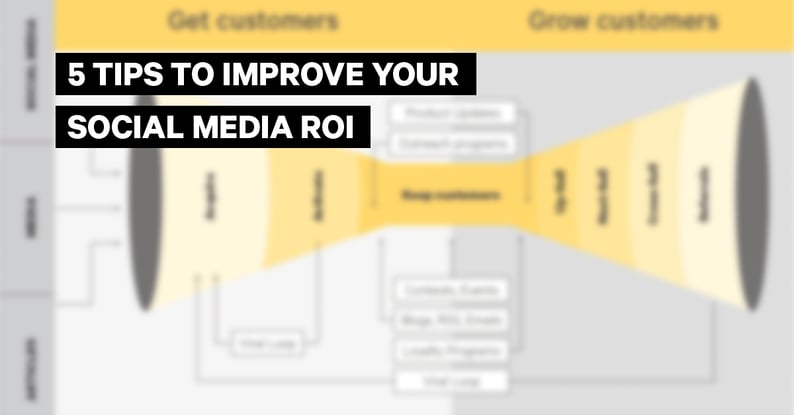by Madeleine Kemp | Feb 26, 2020 | Thinking
5 tips to improve your social media marketing ROI
10 minute read
With 28% of Australians spending longer on social media due to government restrictions Aussie's are currently enduring, it's no wonder marketers are upping their digital ad spend.
But with extra spend comes questions – how is this extra budget impacting on the business's sales? What is the ROI from these campaigns?
Determining social media ROI isn't as straight forward as it might sound. With dozens of metrics available and multiple touch points along the pathway to purchase, it's easy to get stuck wondering where to start.
Do you know the value social media is delivering for your business?
Before we jump into explaining how you can effectively formulate your social media ROI, let’s define what it means.
We define social media ROI as the value gained from all social media actions. Determining the ROI of your social media strategy depends on your business objectives. These might include: brand awareness, enquiries, applications or sales, and, therefore the ROI metric used varies. The following is a commonly used formula we recommend keeping on hand.
PROFITS / INVESTMENTS x 100 = ROI
Limiting social ROI to a dollar amount may prevent you from identifying other ways your ad investment is paying off. For example, if your marketing goal is to increase brand awareness, success would be measured by metrics like audience reach and video views.
Let’s take a look at five ways to improve your social ROI.
1. Focus on tactics that deliver on your business objective(s)
Metrics such as likes and follows are often called “vanity” metrics, but they should only be dismissed if they don’t align with your business objectives. They can be useful for measuring the overall health of your social presence and for keeping an eye on how your brand stacks up against competitors.
Here are three questions you should ask when determining what metrics to measure.
- Does it align with my objectives?
- Does it help me make decisions (what to do more of, what to do less of, etc.)?
- Am I able to measure it effectively?
If you’re still determining your social objectives and benchmarks, the S.M.A.R.T framework may be a good starting point to help keep you on track. Your agreed objectives will then inform the metrics you should be measuring.
Here are some examples of goals that social media can help you achieve:
- Increasing brand awareness
- Establishing your authority on your topic
- Building a loyal community
- Attracting more leads and prospects
- Building relationships with new customers
- Maintaining and improving relationships with existing customers
- Improving customer service
- Increasing sales
2. Test hypotheses and adapt
You might notice that your Instagram carousel posts are performing better than video content, or your short paid video ads outperform longer video ads. Hypotheses ensure you’re collecting data with intent, making analysis more structured and quicker. You can’t prove what you don’t measure, so it’s crucial you use measuring tools to test your hypotheses. As social media algorithms and user preferences are constantly changing, this process should occur as part of your ongoing approach to content planning.
One way to do this is to ensure all content that links outside of Facebook includes UTM tracking. Or use the Google Analytics conversion funnel tool. By setting up conversion goals in Google Analytics, you can easily keep track of which conversions come from where across your social platforms.
At DPR&Co, we’ve found the 70/20/10 model to be highly effective, particularly when it comes to digital media investment. If 70% of your investment goes to your “bread and butter” campaigns i.e. those channels and ads that have previously done well, look to invest 20% on emerging media and 10% on new or “agile” media. Clients that adopt this approach tend to reap the benefits of trying new, risky mediums early on. They also fail quickly and learn constantly, while retaining their results through those more predictable tactics.
3. Nurture leads according to your objective
Facebook has specific tools built for lead nurture/conversion and measurement, so it makes sense to use them. The better you can optimise your ads for more leads and use the existing lead information to drive conversions, the higher your ROI will be.
But the journey doesn’t end there. Once you have your data, the next step is converting your leads to customers or sales. Your lead nurturing efforts will vary depending on the part of the funnel the lead is at. Here’s three possible leads with accompanying tactics.
a) Convert a cold lead to a warm lead – send regular emails with tailored contentb) Encourage a web visitor to sign up – retarget with a Facebook lead generation ad
c) Convert a lead that has abandoned their cart – send an automated email with an offer to entice the customer to purchase
4. Using social to convert
‘Social’ means ‘human interaction’ and without that interaction, your social efforts will fail. Here’s a list of the top 10 reasons people use social:
- Stay in touch with friends and family
- Stay up to date with current events
- Fill spare time
- Find entertaining content
- Network
- Engage with friends
- Share content with others
- Share opinions
- Research/find/buy products
- Meet new people
Think about what content you can produce that will intercept your audience while they’re using social. Can you produce a piece of funny or engaging content that will keep your brand top of mind? Can you create video testimonials that create a positive sentiment around your brand? Spend time understanding the way your audience uses social media and you’ll be more successful at engaging them.
Here are our top three tactics for improving conversions through social:
- Use social proof to your advantage. We like to be reassured before making a purchase and 88% of customers research online before making a purchase. So before sending customers to a product page, lead them to reviews, positive testimonials, user-generated content, media coverage, etc. This will increase the chance of them converting once they’re on your site.
- Retarget previously engaged audiences with tailored content. Use the tools that social platforms offer to deliver content smartly.
- Address your customer’s pain points through purpose-built content delivered at the right time. So use your content to break down any fears, pain points or barriers a customer may have before converting.
5. Managing your social media costs
When you break down the expenses associated with executing a social media strategy, you realise there’s more to consider than you might think.
Generally, you can assign these costs to the following areas:
- Content creation
- Software and tools
- Paid advertising
- Paid partnerships
- Training
- Management
The cost for social management will depend on the scope. The more channels you’re active in, the more resources you’ll need. Consider which channels are going to deliver the most value to your business objectives. Our rule is: do less but do it well. But remember to leave some time for learning and testing!
At DPR&Co, we’ve found that the most cost-effective way to develop social content is to create it in bulk. This will see an initial investment delivering months worth of content. Planning is crucial to pull this out of the bag. Meaning a well thought out social strategy and content plan is a must. However, the nature of social can’t always allow for pre-determined content. Make sure your social manager is leveraging timely opportunities to be clever with agile content. For example, can you relate your brand or offering to a current trend or affair? Are there any posts you’ve been tagged in that you can share immediately? Social is a fast game, too many rules and bottlenecks could work against you.
When it comes to media budget, it’s worth taking the time to do some testing and analysing to set benchmarks and realistic targets. It’s easy to keep spending on social ads, but don’t let the ads define your budget. Instead, do your homework, set benchmarks and invest in training to learn how to improve your results.
Struggling to justify your social media budget? Wondering how to use social to drive your business objectives? Download our infograph below with five tips you can implement today to improve your social ROI.

Let us know what type of content you're most interested in receiving.






